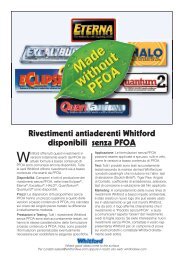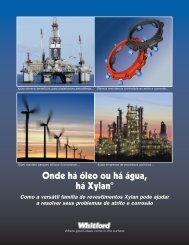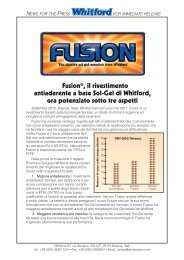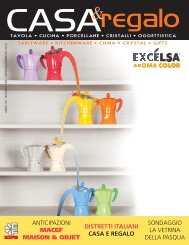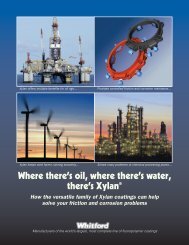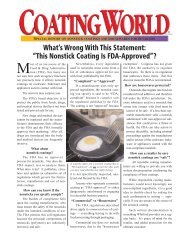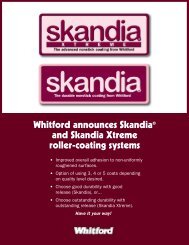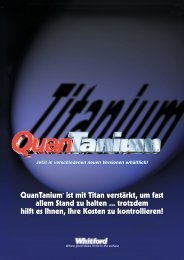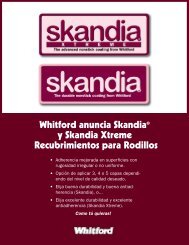Literature PDF
Literature PDF
Literature PDF
- No tags were found...
Create successful ePaper yourself
Turn your PDF publications into a flip-book with our unique Google optimized e-Paper software.
2. High-performance coatings at workFrom the development of the first Xylanproduct (1010), Whitford has modified thebasic formulation to solve specific problems.This has led to new materials and combinationsof materials so that, today, there are more than3,000 different formulations of Xylan.Few products are as beneficial in so manyways as the wide range of Xylan coatings. Thisvery diversity, however, means that propertiescan vary widely.Xylan dry-film lubricants can solve numerousproblems, including friction/wear, corrosion, temperatureextremes, sticking, vibration, galvanicactivity, electrical insulation and conductivity.The selection of a coating depends on determiningthe problem of the application (wear, heat,corrosion, etc.) and matching it with the materialthat most effectively solves the problem.A. FrictionFriction causes heat, wear and loss of energyin dynamic applications. In severe circumstances,friction can cause overheating andseizure.Friction also causes brinelling, galling, scoring,and underloading of fasteners.Drive-line vibration and chatter result fromfriction. In these cases, stick/slip motion is usuallythe cause. This unstable sliding motionoccurs at very slow speeds, when frictionincreases above the force causing the movementand motion stops, then drops below themoving force, at which point motion restarts.Deformation or destruction of delicate mechanismssuch as lock components can becaused by excessive friction.Friction coefficients (measured by matingsurfaces rubbing against a coating) typicallyvary from about 0.06 for PTFE materials to about0.15 for Moly coatings, although values as lowas 0.02 have been measured for some Xylancoatings.Xylan coatings are particularly useful whentemperatures exceed the operating limits of conventionalmineral and synthetic oils. BecauseXylan coatings are based on resin systems witha wide range of temperature capabilities, theycan be used from cryogenic levels to260°C/500°F, with many being stable for briefperiods at 315°C/600°F.Where galling, abrasion, and high energyloss due to friction are anticipated, considerapplying coatings of 25 microns/0.001 inch ormore to minimize friction and wear. (See page24 for this processing information.)Potential applications include rotors for compressors,air-cylinder pistons, hinges, slidingbearings. The best coating choice is the onewhich provides the desired coefficient of frictionand the maximum pressure/velocity (P/V) capability(see sidebar, page 7).Using a Xylan coating in a bearing cavity inwhich a fluid lubricant is also used reduces frictionlosses in the bearing to the lowest possiblelevel because Xylan is oleophobic (it sheds oil).During rotation, viscous shear forces within thebearing are reduced slightly. Thus, instrumentbearings or other systems in which minimumbearing friction is critical can benefit from a thincoating (7.5 microns/0.0003 inch).Excessive friction is also detrimental to boltedjoints, in that much of the tightening torque isexpended overcoming thread-to-thread andbearing-face friction. In these situations, if thebolt is not properly tensioned (preloaded), thejoint can be unexpectedly weak in service.In addition, improperly fastened parts aresubject to backout when vibration occurs.Coating the threads reduces the makeup torqueby as much as 65 percent.Because of its toughness and corrosionresistance, a PTFE-matrix in a thermosettingbinder is preferred for these applications.The oil embargoThe oil embargo of 1974 increased fuel costsas much as 80 percent, catching America withcars that averaged 3.5 km per liter/13.3 mpg.The situation for trucks was even worse.5



